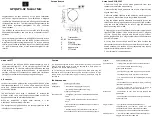
together to create one side of the stereo signal, and
subtracts the side signal from the mid signal to create the
other.The result is a very accurate translation of the stereo
listening field. The presence of an M-S balance control in
the encoder also allows the engineer to control the ratio
of mid signal to side signal, and therefore the perceived
width of the stereo field.
Note that Mid-Side is the only stereo miking technique
that does not rely explicitly on a matched pair of
microphones. However, high quality microphones are
imperative for overall sonic integrity, as well as to ensure
well-balanced capsules within the figure 8 mic. Note also
that Mid-Side offers a great deal of flexibility because the
mid does not have to be a cardioid. If more audience noise or reflections from the back of the room
are desired, an omni could be used as the mid mic to great effect.The Mid-Side technique also offers
excellent mono compatibility because the recombination of the two out-of-phase side signals
cancels them out to leave only the mid or center signal.This process simultaneously minimizes side
reflections that can yield confusion in a mono conversion.
Spaced Omni
The
spaced omni
technique is often used for recording
orchestras. It employs a matched pair of omni mics typically
positioned four to eight feet in front of the sound source.
The mics are normally at the same height as the
performers, although raising them to 10 feet or more in
the air can increase perceived ambience. The distance
between the mics should be approximately 1/3 to 1/2 the
width of the sound stage. While spaced omni provides
excellent depth and stereo image, the center of the field
can tend to be less distinct. In situations where there is too
much unwanted background noise or the mics must be
placed further away due to logistics, experiment with using
carefully placed cardioids or supercardioids with this
spaced mic technique.
As pointed out earlier, spaced miking techniques are not as technically accurate as some correlated
miking techniques. They can be susceptible to phase anomalies owing to reflections entering the
mics from various surfaces in the recording environment although some people actually find this
pleasing. Many engineers consider spaced mic techniques best for recording relatively uncorrelated
sounds such as a pipe organ or outdoor ambience. Spaced techniques are also useful in creating
the surround channels for surround sound.
Decca Tree
Staff engineers at Decca Records (now Thorn-EMI)
developed a technique known as the
Decca Tree
in England
in the 1950s.This method and numerous variations are still
very popular today in the recording of film scores.
A T-shaped fixture houses a microphone classically an
omni at each of its three ends.The two mics at either end
of the cross-arm are positioned approximately two meters
(approx. 79 inches) apart, while the central microphone is
1.5 meters (59 inches) away at the bottom of the T. This
structure is then mounted about eight to ten feet in the air
and positioned so that the central mic is just behind the
conductor s head. The mics are tilted down at about 30
M
+S
-S
Sound Source
The Mid-Side technique electronically
derives a stereo signal from a center mic
coincident with a figure 8
D
D
_
2
D
_
3
~
Sound Source
The spaced omni technique places omnis
at a distance of 1/3 to 1/2 of the sound
stage width from each other
conductor
1.5 m
2 m
Sound Source
The Decca Tree technique is very
popular in film scoring
23
Choosing & Using Microphones
Summary of Contents for Microphone
Page 1: ......
Page 12: ...Choosing Using Microphones 12...
Page 20: ...Choosing Using Microphones 20...
Page 32: ...Choosing Using Microphones 32...













































